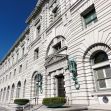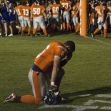Two clauses of the First Amendment went head-to-head in the fight over private versus government speech this past week, as the Supreme Court unanimously ruled that Boston violated the U.S. Constitution when it did not allow a group to fly a Christian flag over the Boston City Hall. However, the narrow decision now paves the way for Boston, and other cities, to create a policy that would preclude these flags to be raised on a government building in the future.
Three flags fly over the Boston City Hall. The first and second are the U.S. Flag and the Massachusetts state flag, respectively, while the third flagpole is available for groups to fly their flag when they gain permission from the city. Other flags approved have included national Pride Week, emergency medical service workers, and even a community bank. When a group doesn’t request to raise a flag, the city routinely raises the city flag.
In 2017, for the first time, the City of Boston rejected a request submitted by a group to raise a flag over the city hall. Harold Shurtleff, the director of Camp Constitution, submitted a request to have permission to raise a Christian flag to coincide with a ceremony for the group. The city rejected the request because they feared the public would view it as the city government endorsing a particular religion, a violation of the Establishment Clause of the First Amendment.
This clause of the First Amendment prohibits governments from signing into law any action “respecting an establishment of religion.” Additionally, a government may not establish an official religion, akin to the Church of England, for example, and cannot favor one religion over the other. Further, the government cannot prefer religion over non-religion, or vise-versa.
In 1971, the Supreme Court defined a multi-factor test for deciding whether a government’s law or action violated the Establishment Clause. The Lemon test, named after the case of Lemon v. Kurtzman, looks at whether a law has a legitimate secular purpose and does not advance or inhibit religion. This test has come under scrutiny over the years by the Supreme Court. Justice Gorsuch, in his concurring opinion in the Boston case, criticized this early decision, stating that the Supreme Court has not applied it “for nearly two decades” but that states and local governments continue to rely on it when defining and enforcing their policies.
The Supreme court ruled unanimously that the rejection of Shurtleff’s application was not constitutional nor was it in line with the city’s precedent of regulating the messaging of that third flagpole. Writing for the court, Justice Stephen Breyer concluded that the city had no meaningful involvement in the regulation of messaging. Therefore, the flag raisings were not government speech and did not reflect the government’s stance. He concluded that this third flag was private speech, which could not be regulated by the government.
Since the City was virtually hands-off when it came to regulating the types of flags that could be raised, it no longer could be seen as governmental speech or speech that could be regulated by the Free Speech Clause of the First Amendment.
Justice Breyer also wrote that nothing prevented Boston from becoming more involved and changing the policy to exclude this private speech moving forward. Justice Samuel Alito and Justice Neil Gorsuch wrote separate opinions concurring with Justice Breyer’s.
Justice Breyer took on a “holistic inquiry” regarding whether the government historically rejected flags because it did not amount to the views of the city or that the public would view the flag as speech by the government. Since the city did not “actively shape[] or control[] the expression” of the flags allowed to be raised, the Court could not argue that it was in fact government speech.
The city had virtually no control over the messages of the flags being raised because there were no guidelines provided by the city on what was permitted or not. Justice Alito reasoned that the city’s program “cannot possibly constitute government speech” because the program “squarely indicate[d] an intent” to allow anyone “who met the City’s basic criteria” to participate.






